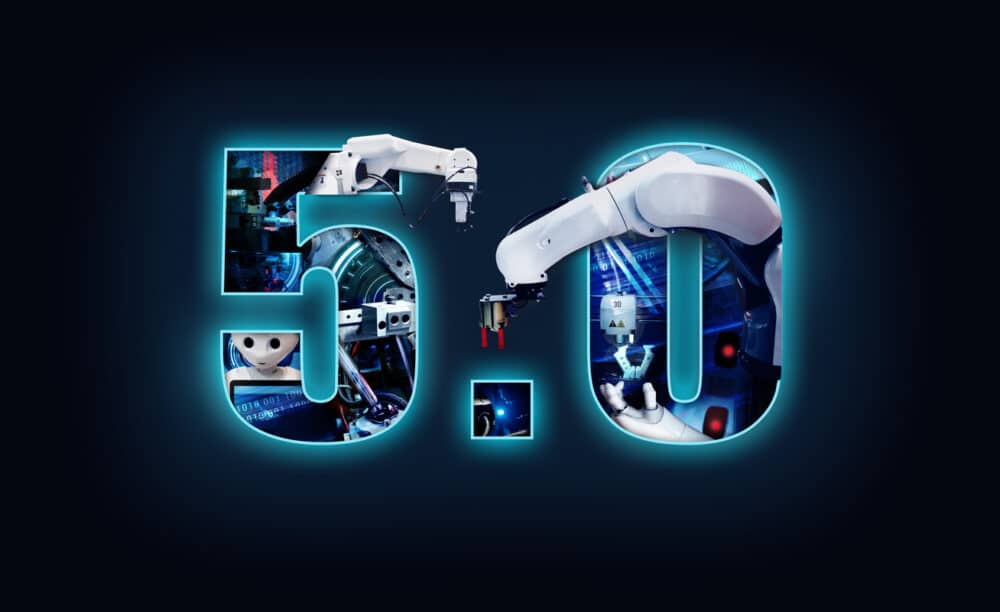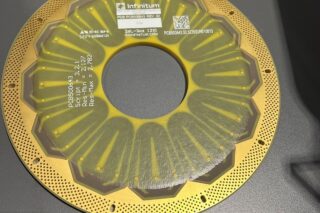While Industry 4.0 marked the era of automation and machine interconnection, with Industry 5.0 humans take center stage in the industrial process. Thanks to artificial intelligence, robotics and the convergence between OT and IT systems, this new revolution redefines the collaboration between people and technology. What are the challenges, and the opportunities involved in this transformation? Khalil Fourati, deputy director of Equans Digital, head of the automation and robotics unit decrypts this change and its impacts on production, process digitalization and product customization.
Industry 4.0 saw the generalized adoption of automation and connected technologies (IoT) within production processes. Its primary aim was to optimize operations, cut costs and improve product quality. With Industry 5.0, we are entering a new era where collaboration between humans and machines is taking center stage. Humans once again have an essential place, not as direct operators but as supervisors and decision makers, guaranteeing more flexible and sustainable production.
IT/OT Convergence
One of the major areas of improvement brought on by Industry 5.0 is based on the convergence between information technology (IT) and operational technology (OT). These two worlds that used to be separate are merging to create a unified environment where the reliability of industrial systems now faces the challenges of IT data integrity and security. This change facilitates the integration of AI and robotics into industrial processes. Robots are becoming more accurate and adaptive, assisted by AI systems that are able to improve the quality of products and optimise operational performance levels.
Human Factor
Industry 5.0 also implies major change management. Humans need to learn to interact with these new technologies, developing intelligent system supervision and management skills as well as an ability to analyse data. Vocational training and academic course content needs to accelerate their adaptation to these new demands.
What are the main challenges and opportunities linked to industrial process digitalization, especially through integrating AI?
Data
One of the main challenges is managing and using data. Industry 5.0 is based on a data-driven approach that requires taking data out of separate silos to make it accessible and usable at every level throughout the company. Yet, many still use fragmented systems and ageing infrastructure. The challenge is therefore to retrieve, centralize and secure this data without invalidating what already exists.
AI
This is where AI plays a key role by allowing an in-depth analysis of this data, deriving value from raw data and improving decision making. Unlike conventional deterministic systems, AI model work on a probabilistic basis, offering extraordinary capacity to learn and adapt. The primary role of the teams at Equans Digital is to minimize the uncertainty linked to these mathematical and statistical methods.
This transformation is based on a deep cultural change and true change management: operators and decision makers need to adapt to these new tools so that they can come to trust them and use them to their full potential. Further, industrial process digitalization opens the way to enhanced competitiveness. By intelligently using data throughout the value chain, companies can improve the flexibility of their production, optimize the maintenance of their machines and enhance their collaboration with their suppliers. This creates a truly intelligent ecosystem, enhancing innovation and operational efficiency.
What role does the so-called Human/IA interaction play in the industry 5.0 transformation in terms of customization and adaptation?
Industry 5.0 marks a turning point in product customization and performance thanks to the interaction between humans and Al. This synergy is used to speed up development of new products while maintaining optimal quality.
For example, AI is used to quickly analyze manufacturing parameters and to optimize the production process. A system that integrates AI can detect product defects or anomalies in the process, suggest real time adjustments to parameter settings and recommend improvements to achieve operational excellence.
This is why we formed Equans Digital Data & AI, an entity dedicated to the specific challenges relating to Al and that call for specialist expertise. This way, Equans Digital has put together and implemented innovative solutions to illustrate this transformation which is taking place in the industrial world.
For example, computer vision and machine learning allow automating complex tasks like sorting eggs or sexing trout, in line with newly applicable regulations. We also use these technologies to perform quality control on holograms applied to official and secure documents like ID cards or passports, thereby guaranteeing unequalled accuracy. Another crucial field of application is that of predictive maintenance. AI is used to continually monitor machine condition, anticipate failures and lower maintenance costs. This ensures improved continuity in operations and more reliable production.
The human-IA interaction transforms the way companies design their products. By using AI right from the R&D phases, they can quickly test different assumptions and adjust production to match market needs. This approach impulses innovation and ensures a relevant response to customer expectations.
Industry 5.0 does not focus on replacing human processes but empowers workers placing them in the center stage of a high-performance technological ecosystem. This approach provides a vision of industry that opens the way to more agile, sustainable production while respecting the challenges of tomorrow.







![Image [Best of 2025] Power Moves in the Energy World](/wp-content/uploads/sites/3/energy-320x213.jpg)
![Image [Best of 2025] How Generative AI Is Transforming Industry](/wp-content/uploads/sites/3/AI-4-320x213.jpg)
![Image [BUYING GUIDE] How to Choose the Right Industrial Robot?](/wp-content/uploads/sites/3/Industrial-Robot-320x213.jpg)

![Image [Buying Guide] How to Choose the Right Safety Shoes?](/wp-content/uploads/sites/3/Safety-Shoes-320x213.jpg)